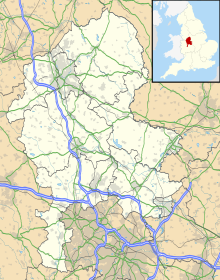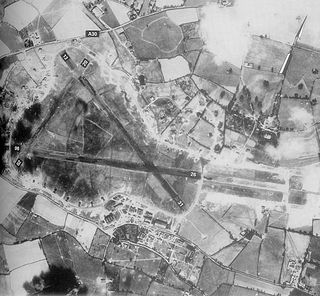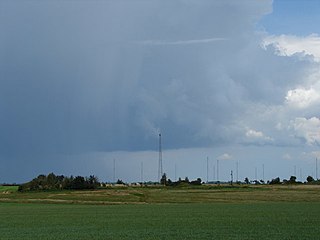
Royal Air Force Digby otherwise known as RAF Digby is Royal Air Force station located near Scopwick and 11.6 mi (18.7 km) south east of Lincoln, in Lincolnshire, England. The station is home to the tri-service Joint Service Signals Organisation, part of Joint Forces Intelligence Group of Joint Forces Command. Other units include the RAF Aerial Erector School, No. 54 Signals Unit and No. 591 Signals Unit.

Royal Air Force Gaydon or more simply RAF Gaydon is a former Royal Air Force station located 5.2 miles (8.4 km) east of Wellesbourne, Warwickshire and 10.8 miles (17.4 km) north west of Banbury, Oxfordshire, England.

Royal Air Force Chelveston or more simply RAF Chelveston is a former Royal Air Force station located on the south side of the A645, 5 miles (8.0 km) east of Wellingborough, near the village of Chelveston in Northamptonshire, England. During the Second World War the airfield was occupied by both the Royal Air Force and the United States Army Air Forces. It was given the USAAF designation Station 105.

RAF Grimsby in Lincolnshire, England, was a Second World War Royal Air Force bomber aerodrome. It initially opened as a satellite station for the Wellington bombers of RAF Binbrook. By early 1943 the station was equipped with Lancaster bombers of 100 Squadron.
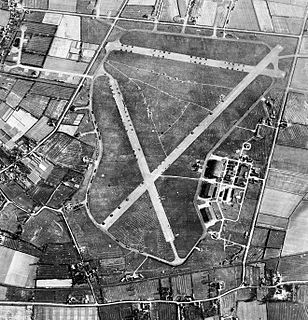
Royal Air Force Goxhill or RAF Goxhill is a former Royal Air Force station located east of Goxhill, on the south bank of the Humber estuary, opposite the city of Kingston upon Hull, in north Lincolnshire, England.
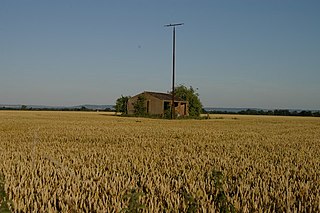
RAF Oakley is a former Royal Air Force station between Oakley and Worminghall, Buckinghamshire, England. It was located in a flat, damp wooded area.

RAF Horsham St Faith is a former Royal Air Force station near Norwich, Norfolk, England which was operational from 1939 to 1963. It was then developed as Norwich International Airport.

Royal Air Force Station Hemswell or more simply RAF Hemswell is a former Royal Air Force station located 7.8 miles (12.6 km) east of Gainsborough, Lincolnshire, England.
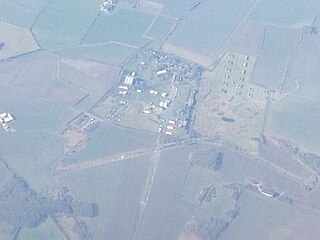
Royal Air Force Faldingworth or more simply RAF Faldingworth is a former Royal Air Force station used during and after the Second World War. It was located close to the village of Faldingworth in Lincolnshire, England.
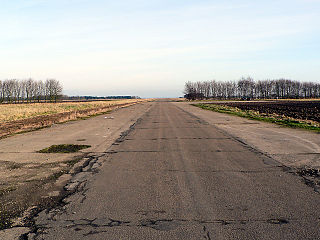
RAF Metheringham was a Royal Air Force station situated between the villages of Metheringham and Martin and 12.1 mi (19.5 km) south east of the county town Lincoln, Lincolnshire, England.
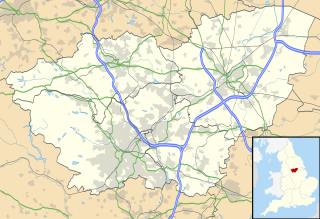
RAF Bircotes is a former Royal Air Force satellite airfield located within South Yorkshire and the Metropolitan Borough of Doncaster and was formerly located within the boundary of Nottinghamshire.

Royal Air Force Station Lissett or more simply RAF Lissett is a former Royal Air Force station located 6.1 miles (9.8 km) south west of Bridlington, East Riding of Yorkshire, England.

RAF Melbourne was a Royal Air Force station during the Second World War. Located 5 miles to the south-west of Pocklington, Yorkshire, England. The nearest village is Seaton Ross.
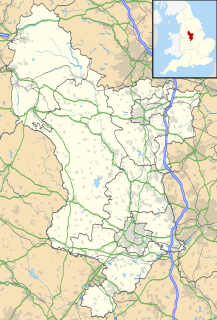
RAF Ashbourne is a former Royal Air Force airfield located approximately 1.5 miles (2.4 km) south-east of the town of Ashbourne, Derbyshire, England.

RAF Balado Bridge is a former military airfield located 2 mi (3.2 km) west of Kinross, in central Scotland. It opened in 1942 as a satellite airfield to RAF Grangemouth, and closed in 1957. It has since served as a NATO satellite station, a microlight flying base, and as the venue for the T in the Park music festival.

Royal Air Force Station Cammeringham or more simply RAF Cammeringham was a Royal Air Force station used by RAF Bomber Command between 1940 and 1945 and the Polish Air Force until 1946. The airfield was located between the A15 and B1398 roads, 10.3 mi (16.6 km) north of the city Lincoln, Lincolnshire, England and due east of the village of Ingham.

RAF Seighford is a former Royal Air Force station located 3.6 miles (5.8 km) northwest of Stafford, Staffordshire, England. The site was opened as a satellite/relief landing ground for RAF Hixon, 7.5 miles (12.1 km) to the east.

Royal Air Force Wheaton Aston or more simply RAF Wheaton Aston was a Royal Air Force station located just outside of the village of Wheaton Aston in Staffordshire, England. The base was actually in the hamlet of Little Onn which is 1.2 miles (2 km) north west of Wheaton Aston. The base was known locally as Little Onn or RAF Little Onn, but the policy of naming Royal Air Force stations was down to which parish the Station Headquarters was in.

Royal Air Force Hixon or more simply RAF Hixon was a Royal Air Force station located on the north western edge of the village of Hixon in Staffordshire, England. The airfield was 7.5 miles (12.1 km) east of Stafford and bounded at the west and north by railways.



